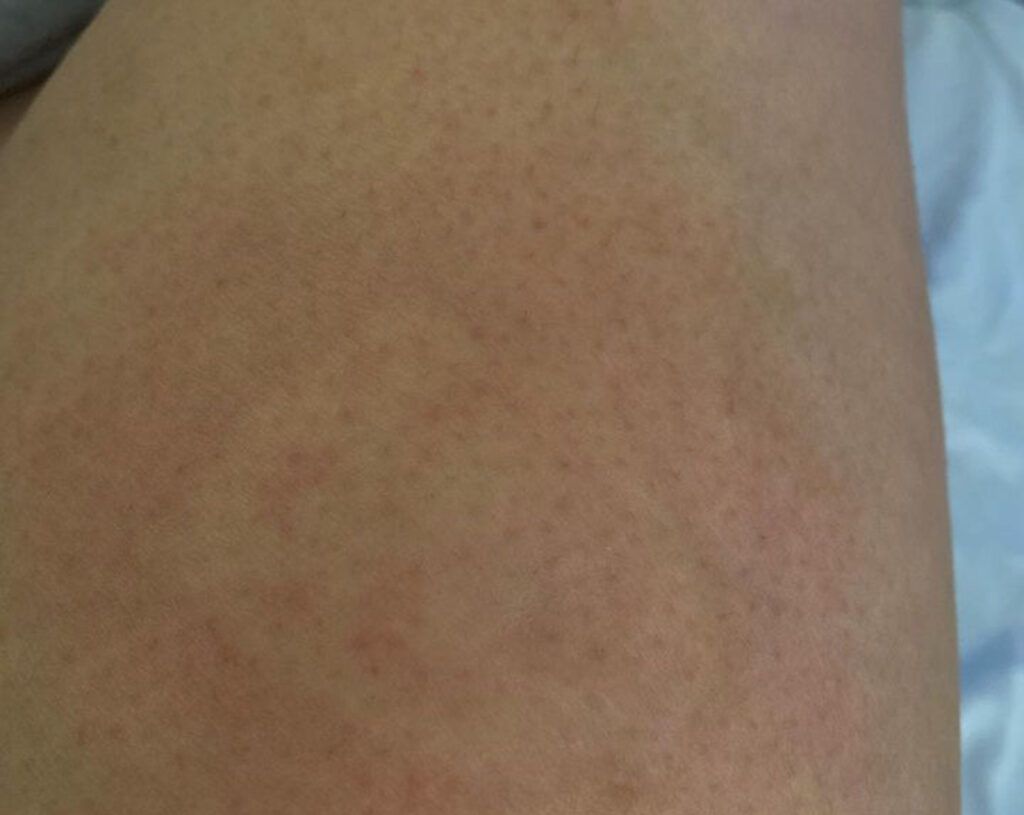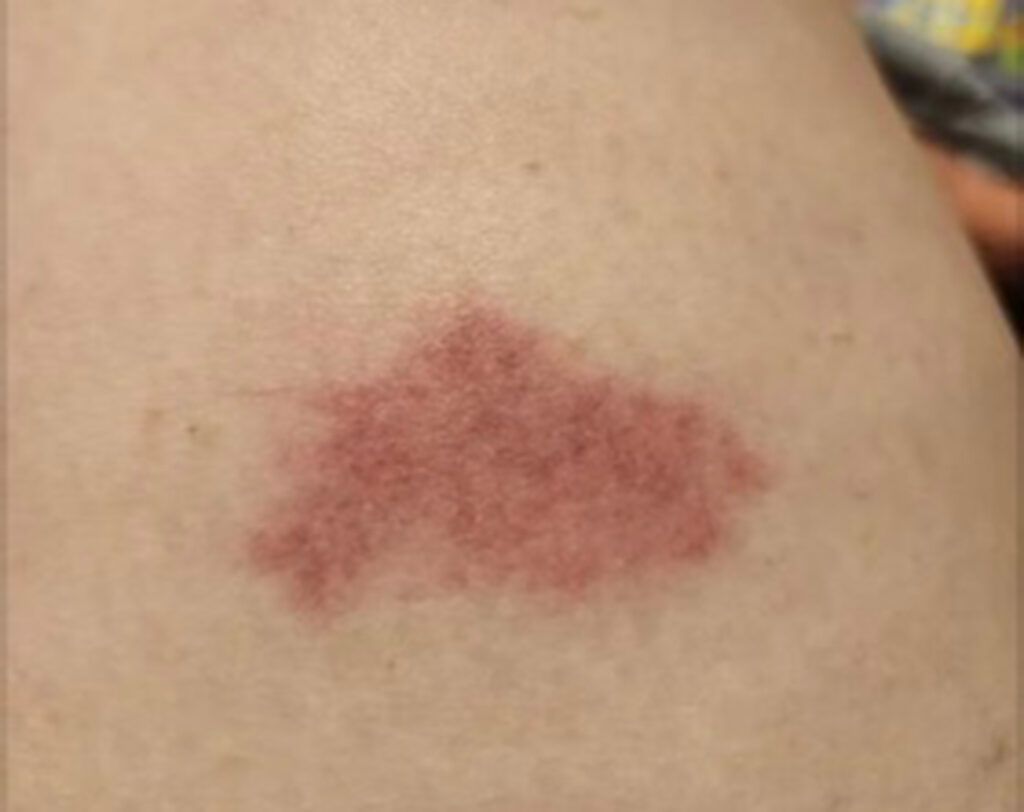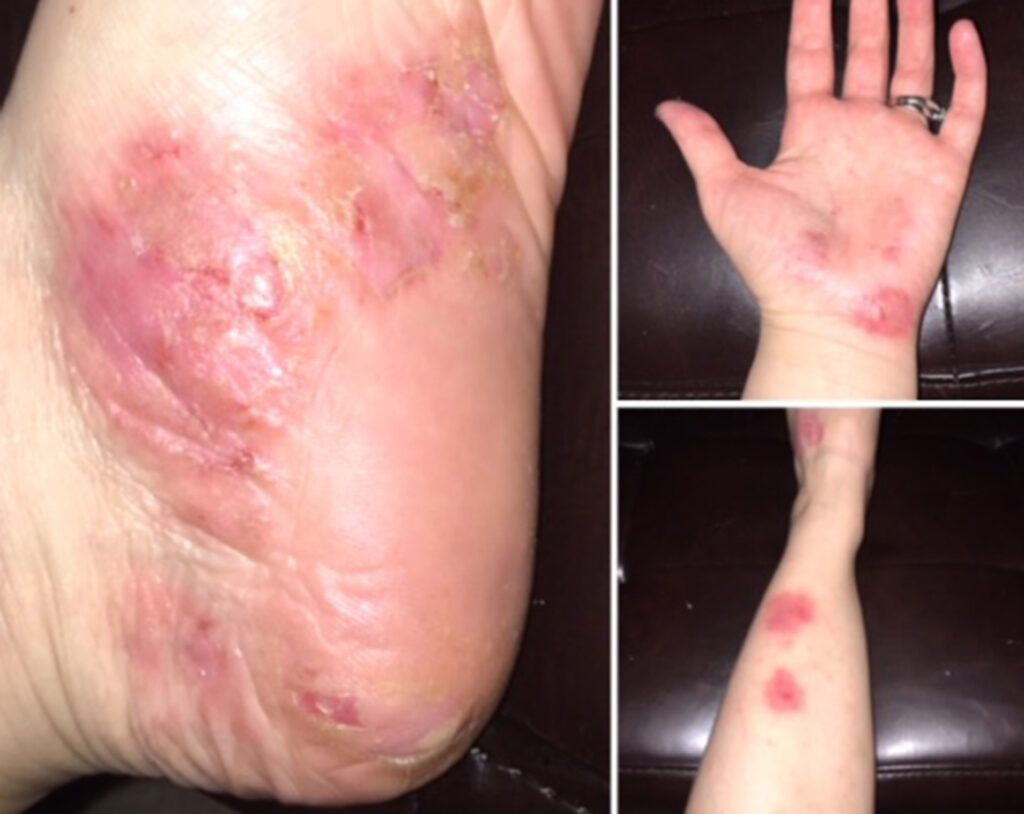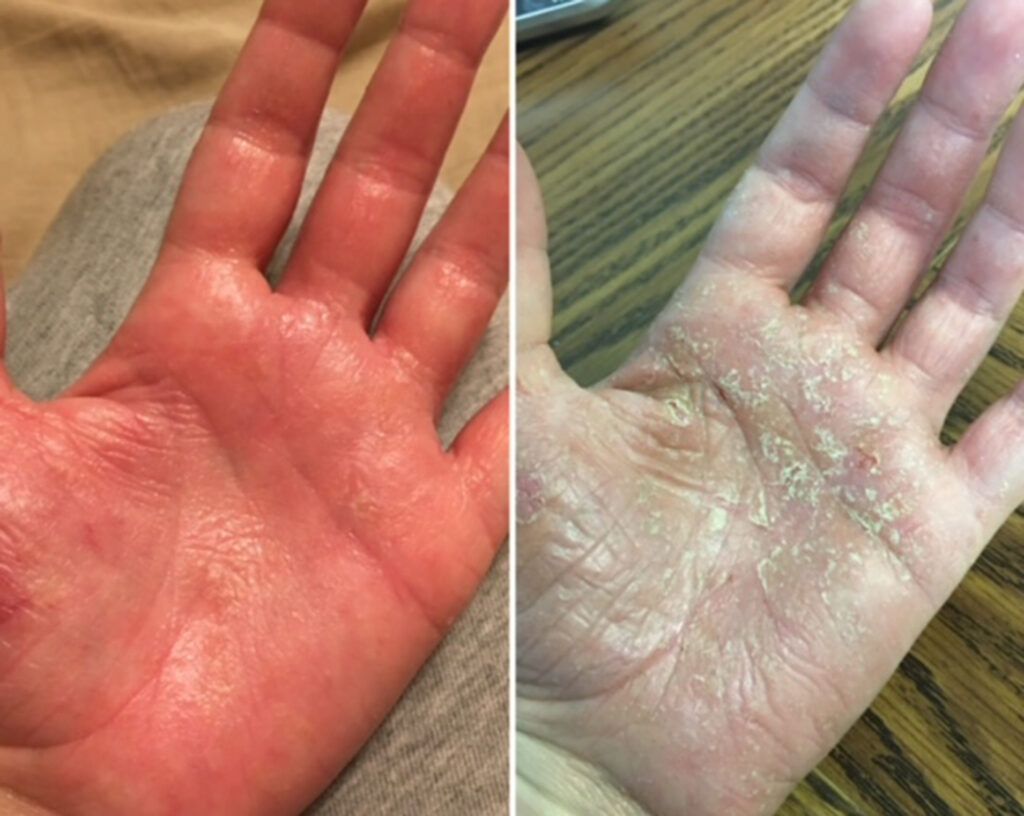Rheumatoid Arthritis and Skin Conditions: Pictures, and What to Expect
October 05, 2023
Content created for the Bezzy community and sponsored by our partners. Learn More

Photography by Carol Yepes/Getty Images
Rheumatoid nodules, vasculitis, and reactions to medications are some potential reasons for skin changes when living with rheumatoid arthritis.
Symptoms associated with rheumatoid arthritis (RA) are often joint-related.
But you may also experience symptoms on your skin, including rashes. In medical lingo, this is often referred to as cutaneous manifestations, with cutaneous referring to the skin.
There are few studies that focus on the prevalence of skin manifestations with RA. One study from 2016, conducted in Germany with 216 patients, found that 27.5% of these patients exhibited RA-related skin manifestations. Research from 2015 notes that those who report skin changes often have more severe cases of RA.
The causes of these rashes and skin changes are poorly understood and need more research. In this article, we’ll review some of the skin changes that can occur when living with or treating RA.


Skin changes and rashes related to RA
Rheumatoid nodules
Although not associated with a rash, rheumatoid nodules are the most common skin change in RA patients, occurring in roughly 25% of all patients. Nodules typically occur in patients with seropositive RA. Other risk factors can include the severity of your RA, a family history of RA, and genetics.
Rheumatoid nodules are located just under the skin and are usually the same color as the surrounding skin. They can be either soft and squishy or firm. They can be small, about the size of a pea, or as large as a lemon at times.
Nodules are usually on the smaller side and painless, but they can interfere with range-of-motion. Sometimes they can sit on a nerve, which can be painful.
They are commonly found at pressure points like the elbow, forearm, toes, and heel.
Treatment of rheumatoid nodules is not usually necessary. If they become infected from open sores, treatment would include antibiotics and wound care. They are very rarely surgically removed.
Sometimes methotrexate (MTX) treatment can accelerate their growth, and is known as accelerated rheumatoid nodulosis. In this case, your medical team may decide to change your medication if you’re having a lot of nodules.
Rheumatoid vasculitis
RA causes inflammation in the joints, but it can also cause inflammation of the small to medium-sized blood vessels. This is called rheumatoid vasculitis, or RV, for short. This is quite rare, with about 1–5% of people with RA experiencing RV.
It usually affects the skin, peripheral nerves, toes, and fingers, but it can also affect any organs of the body and cause various symptoms.
One typical symptom is a rash on the legs, which can be painful. On lighter skin, it might be a red or purplish color. On darker skin tones, it might appear as a deeper red or purple. More severe cases will have open sores, larger lesions, or larger open ulcerations on the legs, fingers, or hands.
In very advanced cases, RV can be life threatening causing stroke or heart attack.
Typically, treatment will involve corticosteroids or immunosuppressants such as Rituximab. These may be used in combination.
Neutrophilic dermatosis
Neutrophilic dermatosis are very rare, extra-articular (outside of the joints) manifestations of RA. They refer to a group of inflammatory skin diseases that include Sweet’s syndrome, among others.
Neutrophilic dermatoses are more commonly seen in severe cases of RA and usually appear as symmetric lesions that can be round or flat. They can be relatively large, pus-filled, and inflamed, or they might appear as a simple, bumpy rash that will not go away. On lighter skin, they might appear red. On darker skin, they may appear darker red.
Neutrophilic dermatosis can go away on their own without any treatment, but in rare cases they can become aggressive and affect other body parts, like the skin around your eyes. Through the course of the rash, the healthy surrounding tissues may die, and this may cause permanent scarring.
Treatment options may usually include topical or systemic steroids, a variety of immunomodulatory therapies, or topical calcineurin inhibitors, such as cyclosporin or tacrolimus.
“I get flat, red plaques on my fingers and toes sometimes, usually with flares. I don’t medicate right away, if at all. I monitor them and watch my lifestyle, specifically diet and exercise, very closely to best manage my skin.”
– Hayley W., diagnosed with RA in 2020
Other causes related to RA
There are several other possible causes of rashes while living with RA. These include:
- palmar erythema
- interstitial granulomatous dermatitis, also known as rheumatoid papules
- livedo reticularis
- urticaria, also known as hives
- atopic dermatitis, also known as eczema
Recent research is not readily available for each of these conditions in relation to RA. However, previous findings and clinical knowledge suggest that they are a possibility. For example, palmar erythema has been reported to occur in over 60% of patients with RA, and presents as reddened palms.
Skin changes and rashes related to medications for RA
Injection site reactions
Many biologic medications can cause an injection site reaction. These reactions can also occur at previous injection sites. These are typically tolerable and do not correlate with how efficient the biologic is for the treatment of RA.
Injection site reactions do not require treatment and usually go away on their own.

“I take Humira every other week to treat my RA and I get the same rash around my injection site every time. It goes away on its own. It helps if I rotate the injection sites.”
– Nilka R., diagnosed with RA in 2017

“I have an injection site reaction every time I administer my RA medications. They go away just in time for me to be due for the next dose.”
– Stefanie R., diagnosed with RA in 2018
Allergic reaction
There is always a possibility of allergic reactions with any medications. The most mild is an injection site reaction. It’s possible to have more severe allergic reactions as well, although it’s rare.
Jenni W. is an RA warrior and advocate, known as gracefully_jen on Instagram. She is the host of My Spoonie Sisters podcast, and was diagnosed with RA in 2012.
In 2017, Jenni changed medication and had a very rare, but very serious, allergic reaction called pustular psoriasis. This causes discolored, scaly skin patches. Pustular psoriasis can be triggered by starting or stopping medications, among other causes.


In this case, she responded with the right course of action and notified her rheumatologist right away, and stopped the medication.
Other causes related to RA medications
A number of other skin changes and symptoms can occur with RA medications:
- Skin fragility: Topical steroids that might be used to treat symptoms of RA can thin your skin over time. This can make you more prone to cuts and scratches.
- Easy bruising: Nonsteroidal anti-inflammatory drugs (NSAIDs) can cause easy bruising. Additionally, thrombocytopenia, or low platelets, is caused by some biologic medications and MTX, which can contribute to easy bruising.
- Sun sensitivity: Many medications used to treat RA can cause sun sensitivity. Specifically, MTX and Plaquenil.
- Skin cancer: Tumor Necrosis Factors (TNF) inhibitors, like Remicade (infliximab), Enbrel (etanercept), Humira (adalimumab), Cimzia (certolizumab), and Simponi (golimumab), can increase your risk of certain types of skin cancer over time.
- Hyperpigmentation: Plaquenil, a type of NSAID, and doxycycline or minocycline, which are types of antibiotics, can be associated with hyperpigmentation.
“I’ve almost always had a strong sensitivity to the sun since starting medications for RA, especially Methotrexate and after most of my infusions.”
– Shelley F., diagnosed with RA in 2012
What should you do if you develop a rash?
If you have RA and you develop a rash, bump, or notice any changes in your skin, the first thing to do is to take photos and call your doctor. Keep in mind that most serious rashes are very rare, but it’s always worth the time to be vigilant and careful with your health.
Even with the best scheduling team, it’s very common for skin to improve or change prior to your next available doctor’s appointment. Photos can help you document changes and communicate with your doctor more clearly.
For some great tips on how to photograph your skin, check out this resource from the American Academy of Dermatology.
The takeaway
If you have RA, there are a number of different skin symptoms that you could experience. The most common is rheumatoid nodules, while rheumatoid vasculitis and neutrophilic dermatosis are far more rare. You may also experience changes to your skin due to medications, including fragility, bruising, sun sensitivity, and symptoms from allergic reactions.
If you develop a rash, bump, or notice any changes in your skin, remember to first take a photo and then call your doctor.
Keep in mind that most serious rashes are very rare, and other common skin changes will likely resolve on their own.
“Never blame yourself for the skin condition that’s happening. It’s not your fault. It’s not because of poor hygiene. It’s because you have an autoimmune condition.”
– Shelley F., diagnosed with RA in 2012
*All quotes were shared with permission.
Medically reviewed on October 05, 2023
8 Sources


Like the story? React, bookmark, or share below:
Have thoughts or suggestions about this article? Email us at article-feedback@bezzy.com.
About the author